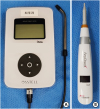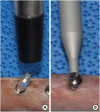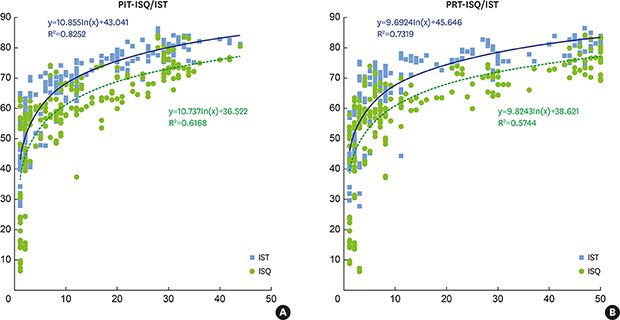1. Oh JS, Kim SG, Lim SC, Ong JL. A comparative study of two noninvasive techniques to evaluate implant stability: Periotest and Osstell Mentor. Oral Surg Oral Med Oral Pathol Oral Radiol Endod. 2009; 107:513–518.


2. Zix J, Hug S, Kessler-Liechti G, Mericske-Stern R. Measurement of dental implant stability by resonance frequency analysis and damping capacity assessment: comparison of both techniques in a clinical trial. Int J Oral Maxillofac Implants. 2008; 23:525–530.

3. Becker W, Hujoel P, Becker BE. Resonance frequency analysis: comparing two clinical instruments. Clin Implant Dent Relat Res. 2018; 20:308–312.


4. Jaramillo R, Santos R, Lázaro P, Romero M, Rios-Santos JV, Bullón P, et al. Comparative analysis of 2 resonance frequency measurement devices: Osstell Mentor and Osstell ISQ. Implant Dent. 2014; 23:351–356.

5. Lages FS, Douglas-de Oliveira DW, Costa FO. Relationship between implant stability measurements obtained by insertion torque and resonance frequency analysis: a systematic review. Clin Implant Dent Relat Res. 2018; 20:26–33.


6. Choi HH, Chung CH, Kim SG, Son MK. Reliability of 2 implant stability measuring methods in assessment of various periimplant bone loss: an
in vitro study with the Periotest and Osstell Mentor. Implant Dent. 2014; 23:51–56.


7. Bilhan H, Cilingir A, Bural C, Bilmenoglu C, Sakar O, Geckili O. The evaluation of the reliability of Periotest for implant stability measurements: an in vitro study. J Oral Implantol. 2015; 41:e90–5.
8. Lekholm U, Zarb GA. Patient selection and preparation. In : Branemark PI, Zarb GA, Albrektsson T, editors. Tissue-integrated prostheses: osseointegration in clinical dentistry. Chicago (IL): Quintessence;1985. p. 199–209.
9. Meredith N, Alleyne D, Cawley P. Quantitative determination of the stability of the implant-tissue interface using resonance frequency analysis. Clin Oral Implants Res. 1996; 7:261–267.


10. Brizuela-Velasco A, Álvarez-Arenal Á, Gil-Mur FJ, Herrero-Climent M, Chávarri-Prado D, Chento-Valiente Y, et al. Relationship between insertion torque and resonance frequency measurements, performed by resonance frequency analysis, in micromobility of dental implants: an
in vitro study. Implant Dent. 2015; 24:607–611.


13. Geckili O, Bilhan H, Cilingir A, Mumcu E, Bural C. A comparative
in vitro evaluation of two different magnetic devices detecting the stability of osseo-integrated implants. J Periodontal Res. 2012; 47:508–513.


14. Atsumi M, Park SH, Wang HL. Methods used to assess implant stability: current status. Int J Oral Maxillofac Implants. 2007; 22:743–754.

15. Açil Y, Sievers J, Gülses A, Ayna M, Wiltfang J, Terheyden H. Correlation between resonance frequency, insertion torque and bone-implant contact in self-cutting threaded implants. Odontology. 2017; 105:347–353.


16. Han HC, Lim HC, Hong JY, Ahn SJ, Han JY, Shin SI, et al. Primary implant stability in a bone model simulating clinical situations for the posterior maxilla: an
in vitro study. J Periodontal Implant Sci. 2016; 46:254–265.



17. Santamaría-Arrieta G, Brizuela-Velasco A, Fernández-González FJ, Chávarri-Prado D, Chento-Valiente Y, Solaberrieta E, et al. Biomechanical evaluation of oversized drilling technique on primary implant stability measured by insertion torque and resonance frequency analysis. J Clin Exp Dent. 2016; 8:e307–11.

18. Turkyilmaz I, Sennerby L, Yilmaz B, Bilecenoglu B, Ozbek EN. Influence of defect depth on resonance frequency analysis and insertion torque values for implants placed in fresh extraction sockets: a human cadaver study. Clin Implant Dent Relat Res. 2009; 11:52–58.


19. Lachmann S, Laval JY, Jäger B, Axmann D, Gomez-Roman G, Groten M, et al. Resonance frequency analysis and damping capacity assessment. Part 2: peri-implant bone loss follow-up. An
in vitro study with the Periotest and Osstell instruments. Clin Oral Implants Res. 2006; 17:80–84.

20. Falco A, Berardini M, Trisi P. Correlation between implant geometry, implant surface, insertion torque, and primary stability:
in vitro biomechanical analysis. Int J Oral Maxillofac Implants. 2018; 33:824–830.


21. Lachmann S, Jäger B, Axmann D, Gomez-Roman G, Groten M, Weber H. Resonance frequency analysis and damping capacity assessment. Part I: an
in vitro study on measurement reliability and a method of comparison in the determination of primary dental implant stability. Clin Oral Implants Res. 2006; 17:75–79.

22. Marquezan M, Osório A, Sant'Anna E, Souza MM, Maia L. Does bone mineral density influence the primary stability of dental implants? A systematic review. Clin Oral Implants Res. 2012; 23:767–774.












 PDF
PDF ePub
ePub Citation
Citation Print
Print






 XML Download
XML Download